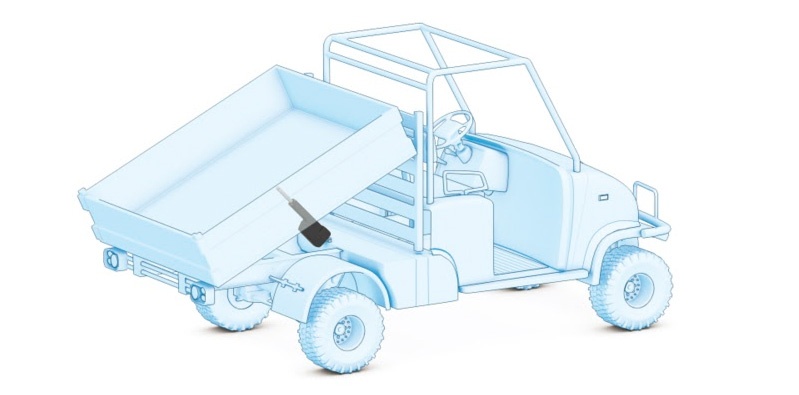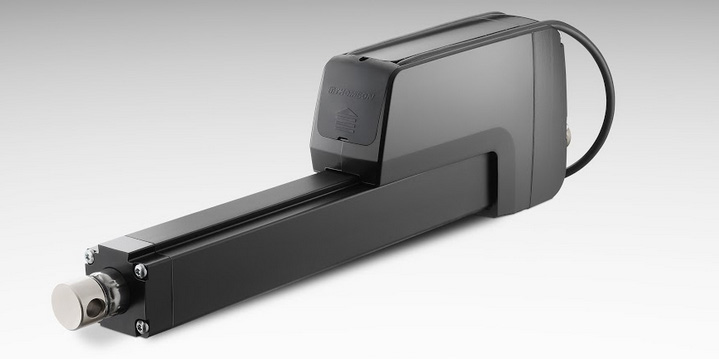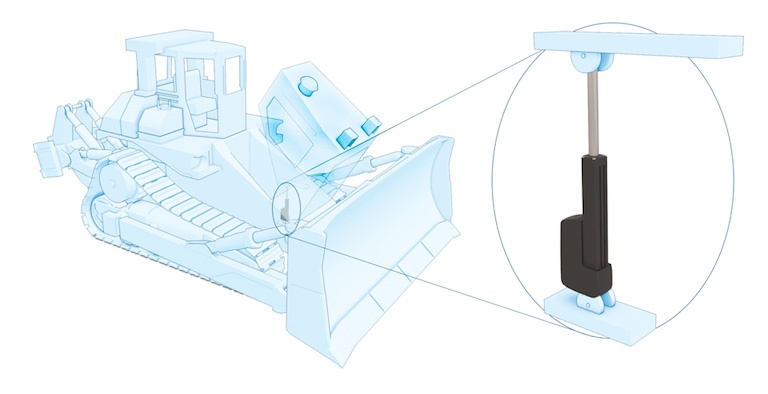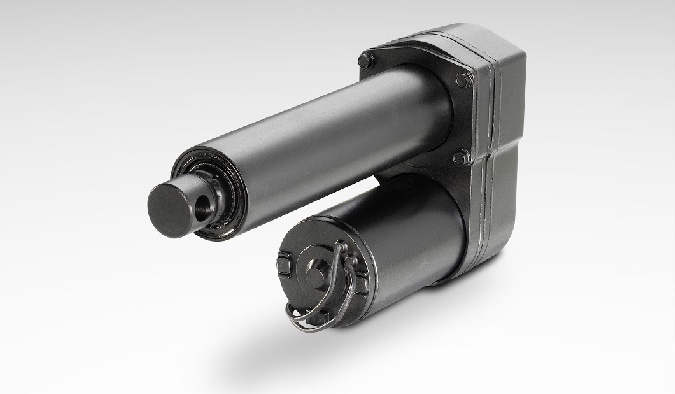To ensure optimum performance of heavy duty off-highway vehicles such as earth-moving equipment, loaders, and rollers, good practice dictates raising the engine compartment hood and inspecting the engine before each shift. This is becoming increasingly challenging, however, as the demand for greater engine functionality often requires larger engine compartments, which, in turn, creates a need for larger, heavier hoods.
The heavier the hood, the more difficult it is to lift it manually, close it easily, and keep it closed. This also increases the need for mechanical assistance. Gas springs and hydraulic cylinders have been the most common technologies used to assist in engine hood manipulation, but both have reliability, safety, and total cost of ownership issues. These issues become more pronounced as engine hoods get heavier. Because electromechanical linear actuators overcome these drawbacks while adding additional capabilities, they are becoming the hood lift solution of choice.
Where gas springs and hydraulic cylinders fall down
Gas springs, also known as pneumatic actuators, provide power to raise the hood with minimal manual augmentation. When the gas spring is new, the power that is so helpful in lifting the hood must be countered to close it, which is usually accomplished with the addition of a pull cord of some sort. A more significant issue is that the springs lose strength as they age – up to 5 percent per year by some estimates – and will eventually fail.
Another limitation of gas springs is their dependence on gas pressure, which is highly subject to temperature fluctuation. This makes them unreliable in extreme temperatures. In some applications, if the gas spring fails, the operator has to climb on the equipment to open the hood, which introduces the possibility of a slip-and- fall accident.
Because of such drawbacks, gas springs have traditionally not been deployed for lifting heavier engine hoods, a task which had been relegated to hydraulic cylinders. However, these cylinders have drawbacks of their own.
For one, they require a separate pump, which must be powered while the engine is running. A few use pumps that can be pressurized manually, but this requires additional time and effort on the part of the operator. Hydraulic cylinders also require more maintenance than gas springs and have a higher need for protection from dirt, grime and other substances that might interfere with operation.
The rising popularity of electromechanical actuators
A growing number of off-highway vehicle manufacturers are now choosing electromechanical actuators to overcome the drawbacks of both gas and hydraulic systems. Compared to gas springs, electromechanical actuators maintain their strength over a longer period of time, typically exceeding 10 years of life. And once the hood is up, it takes no effort to pull it closed because the actuator applies force in both raising and lowering the hood. Once closed, the actuator keeps it in position without the need for latches.
Compared to hydraulic cylinders, electromechanical actuators can be powered directly from the engine’s battery, eliminating the need to keep the engine running. In terms of strength, hydraulic actuators hold little to no advantage over electromechanical actuators on the typical hood lift. Where traditional electromechanical actuators could handle 1500 pounds (6.8 kN) in the past, it is now typical for most to handle up to 2250 pounds (10 kN). One company, Thomson Industries, Inc., will soon be offering an electromechanical actuator that can handle up to 3035 pounds (13.5 kN), which is powerful enough to handle just about any engine hood available today. When implemented with onboard electronics, electromechanical actuators can also be implemented across multiple axes.
Additionally, electromechanical actuators are more tolerant to temperature extremes and challenging environments than either gas or hydraulic cylinders. They can typically achieve IP69k (static), IP67 (static) and IP66 (dynamic) Ingress Protection ratings, which allow them to be exposed to high-temperature, high-pressure washes. This simplifies the cleaning of equipment that has operated in some of the harshest environments. They can also operate in temperatures ranging from -40 to 85°C (-40 to 185°F), withstand salt spray for 500 hours and are often CE, RoHS and REACH certified.
The electrical capabilities of electromechanical actuators provide additional advantages over gas springs and hydraulic cylinders. The actuators can, for example, be operated with an electrical switch, eliminating the need for the operator to climb on the equipment to release the latch or enlist the help of a colleague to do so.
Onboard electronics provide additional flexibility, improving control and communication, which reduces operating costs, requires less space, and simplifies setup and installation. When implemented with J1939 CAN bus communications, these onboard electronics can be controlled and monitored using a computer or any other programmable device running the protocol. This can be performed on site or even remotely, avoiding the unnecessary relocation of the operator. It also enables smooth motion and feedback of the cylinder if required. They can also be fitted with a manual override, which enables operation should the main battery be too weak to power it.
Onboard electronics also enable low-level switching, end-of- stroke indication output, choice of analog or digital feedback, and a customer control interface, providing additional versatility.
Leveraging electromechanical power
Taking advantage of the power and versatility of electromechanical actuation requires a close collaboration between the vendor and the equipment manufacturer. Because hood designs are unique to each vehicle, each will deploy electromechanical actuation at different locations on the hood and in the engine compartment. To help manufacturers determine which is right, the actuator vendor will typically apply proprietary load cell analysis tools. They can also calculate voltage, power supply and speed requirements to provide the right size actuator that will deliver performance at the lowest cost over the desired lifetime of the equipment.
Overall, from an end-user perspective, electromechanical actuators are more reliable, more functional, safer and less expensive to own and operate compared with gas or hydraulic cylinders. This is why equipment manufacturers increasingly call them out as design features.
Case history (sidebar): Electromechanical hood lift enhances safety and convenience for large earth-moving equipment
A UK-based designer and manufacturer of large off-highway earth-moving equipment was concerned that the engine compartments of its equipment had become so enormous they could not be raised by hand. Also, safety was a top priority for them, and they wanted to find a way for operators to raise the hood without having to climb up on the vehicle. They concluded that a switch-activated electromechanical actuator would solve the problem, provided there would still be a way to raise or lower the hood manually in the event of a power failure or other malfunction.
Working closely with motion control engineers from Thomson Industries, Inc., who calculated the load required to open and close the hood, the company chose a Thomson LA 10 Series linear actuator, which also was fitted with hand wind functionality that could raise or lower the hood manually. Now, users of that equipment can open and close the hoods without leaving the cabin if need be, even in the absence of battery power.

Thomson’s electric linear actuators with J1939 CAN bus communication provide
efficiently controlled performance for garden, construction and service vehicles.

The Electrak® HD™ electric linear actuator from Thomson Industries offers industry
leading, onboard electronics with built-in J1939 CAN bus option that enhances controllability,
can eliminate individual controls and simplifies OEM machine design.

Built-in support for the SAE J1939 CAN bus standard opens exciting new possibilities
for the integration of electromechanical actuators into agricultural, construction and mobile-off-
highway applications

Robust, strong and virtually maintenance free, Thomson’s Electrak® 10 actuators
incorporate a screw drive system for applications requiring maximum load capacity.


